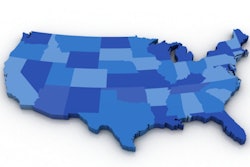
In the Medicare population, imaging use and costs vary far more at the county level than at the state level, according to a new study published online March 10 in the Journal of the American College of Radiology.
The findings suggest that imaging use in Medicare is more influenced by local socioeconomic factors -- ones that tend not to be considered in traditional beneficiary-focused policy-making. These factors should be considered when making Medicare policy, said researchers from the Harvey L. Neiman Health Policy Institute (HPI), who conducted the study.
"Policy efforts to standardize and reduce variation in imaging intensity across the country should consider the high variability existing at county-level geographic units, and focus less on national 'one size fits all' approaches," said contributing author Dr. Richard Duszak Jr. in a statement released by the institute.
Wide variety
Lead author Dr. Andrew Rosenkrantz from NYU Langone Medical Center and colleagues used data from the 2013 U.S. Centers for Medicare and Medicaid Services' Geographic Variation Public Use File to identify county-level per capita Medicare fee-for-service imaging use. The group also used the County Health Rankings and Roadmaps database to identify county-level measures of population economic status.
Overall, county-level unemployment rates and the rates of uninsured people younger than 65 were linked to greater imaging resource use and costs, the researchers found.
"Higher uninsured and unemployed rates at the county level were both independently associated with higher Medicare imaging utilization and costs," the group wrote. The reason for this may be that "higher unemployment and uninsured rates may be associated with more fragmented care."
More specifically, Rosenkrantz and colleagues found that imaging events per 1,000 Medicare beneficiaries varied 1.8-fold by state, but 5.3-fold at the county level; per capita imaging costs to Medicare varied 4.2-fold at the state level and 14.1-fold at the county level. Within individual states, county-level imaging use varied twofold on average.
"Policymakers are looking to 'right size' imaging payments, but that right size can vary quite a bit among populations," Rosenkrantz told AuntMinnie.com. "Our study findings suggest that a target that's helpful in one region may not apply as well somewhere else."
Now what?
So what's next? More research, according to the group.
"Future studies of other potential indigenous drivers of imaging beyond economic disparity should target smaller (rather than state-level) markets whenever possible," the authors wrote.
As for radiologists themselves, the study is a reminder of the importance of understanding one's local patient mix during the shift from volume-based to value-based payment models and in positioning one's practice to succeed.
"Radiologists need to consider how patient characteristics play into their practices," Rosenkrantz said.
Will policymakers listen? That's the hope, according to Rosenkrantz.
"We certainly hope policymakers and other stakeholders are getting this message regarding these wide disparities, even at small geographic levels, which are not always readily appreciated," he said. "Policies should consider these explored sources of variability, and we need models that are flexible."




















